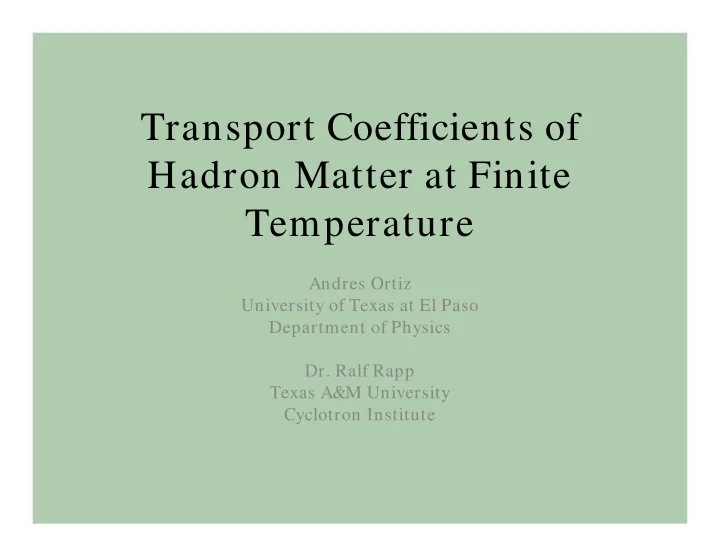

Transport Coefficients of Hadron Matter at Finite Temperature Andres Ortiz University of Texas at El Paso Department of Physics Dr. Ralf Rapp Texas A&M University Cyclotron Institute
Objectives • To obtain electrical conductivity and shear viscosity. • To obtain in-medium to non-interacting Euclidean correlator ratio.
Introduction
QCD Potential and Quark Confinement • QCD potential becomes linear • Force becomes constant • Energy required to overcome potential is infinite • Color confinement
Phase Transition • Phases of QCD matter • Phase transition around 200MeV • Plasma of deconfined quarks and gluons
Quark-Gluon Plasma • The study of QGP is essential for the understanding of strongly interacting matter. • Also, it is believed that during the first 10 -6 s of the universe’s existence it was occupied totally by QGP.
Heavy Ion Collisions • SPS • RHIC • Accelerated gold nuclei • Kinetic energy is converted mostly into thermal energy • QGP is expected to exist for around 10 - 23 s
Probes for the QGP • The fireball created after the collision is not directly observable so physicists have to devise methods for extracting information from it. • People look at the spectrum of the produced particles in order to be able to make conclusions about the first stages of the fireball.
Dilepton Production • Quark anti-quark annihilation • Decay of photon into dilepton • Leptons interact very weakly with the plasma
Project
Dilepton Production Rate • One of the properties that is observed by physicists is the dilepton production rate: d 4 xd 4 q em 2 dN 3 M 2 f B ( q 0 ; T ) 1 3Im em ( M , q ; B , T ) (1) • This is related to the electrical conductivity by the imaginary part of the electromagnetic current-current correlator • Theoretical calculations of the correlator from (1) are used.
Electrical Conductivity The electrical conductivity describes the response of a system • under an electrical potential difference. According to the Kubo formula the conductivity can be obtained from the low frequency limit of the pertinent spectral function. ( q 0 ,0) e 2 6 lim q 0 0 q 0 ( q 0 , q ) Im em ( q 0 , q ) M 2 q 2 q 0
Spectral Function at T=180 MeV 6000 5000 4000 rho_ii [MeV^2] SPS 3000 SPS fit RHIC RHIC fit 2000 Pion Cloud Pion Cloud fit 1000 0 0 50 100 150 200 250 300 -1000 q0 [MeV]
Conductivity 0.03 0.025 0.02 Sigma/m_pi SPS 0.015 RHIC Pion Cloud 0.01 0.005 0 0 50 100 150 200 Temperature [MeV]
Resonances • Interactions can lead to formation of mesons • Pion meson is likely to be formed • Interactions can be regarded as particles themselves • First approximations from kinetic theory of an interacting hadron gas
Shear Viscosity • Shear viscosity describes the response of a fluid to gradients in velocity. • Simple expressions of transport coefficients can be used to find a relationship between conductivity and viscosity. k B m e 2 T
Viscosity 2.5 2 eta*e^2/m_pi [GeV*e^2] 1.5 SPS RHIC 1 Pion Cloud 0.5 0 0 50 100 150 200 T [MeV]
Shear Viscosity to Entropy Density Ratio • Once viscosity is obtained, theoretical calculations of entropy density at the corresponding conditions are used to find the shear viscosity to entropy density ratio.
Viscosity to Entropy Density Ratio 0.5 0.45 0.4 0.35 eta/s *(e^2/m_pi) 0.3 SPS 0.25 RHIC 0.2 Pion Cloud 0.15 0.1 0.05 0 0 50 100 150 200 T [MeV]
Euclidean Correlators Euclidean correlators can be calculated from a transform of the spectral • function: ( q 0 , q ) cosh( q 0 ( 1/2 T )) dq 0 ( , q ) 0 sinh( q 0 /2 T ) The low energy part of the spectral function is the same one used for the • calculations of conductivity. The high energy part is given by the following model: • 2 cont ( q 0 ) q 0 1 0.22 1 exp[( E q 0 )/ ] 1 (2) 8 ln[1 q 0 /(0.2 GeV )] In the non-interacting case the spectral function is: • 2 ( q 0 ) q 0 8 Finally, the ratio of in-medium to non-interacting Euclidean correlators is • calculated.
In-medium Non-Interacting 100000 100000 10000 10000 1000 1000 100 In-medium 100 Non-Interacting 10 10 1 1 0 0.5 1 1.5 2 2.5 3 0 0.5 1 1.5 2 2.5 3 0.1 0.1 1.5 1.45 1.4 1.35 1.3 1.25 Ratio 1.2 1.15 1.1 1.05 1 0 0.1 0.2 0.3 0.4 0.5 0.6 τ T
Lattice QCD • Lattice QCD is an approach that consists of approximating solutions by dividing the space with a grid. By reducing the size of the grid, or lattice, approximations become closer to real ones but with the price of requiring more computing power. • Data obtained from the lattice supposed to represent reality. 1.5 1.45 1.4 1.35 1.3 1.25 Ratio 1.2 1.15 1.1 1.05 1 0 0.2 0.4 0.6 τ T
Conclusions and Further Work • Results for conductivity and viscosity do not agree with existing literature • A different approach will be used involving less uncertainty • Euclidean correlator ratio shows agreement with recent lattice calculations • This agreement is evidence that the models used throughout this work reflect properties of physical reality
References • 1. R. Rapp and J. Wambach, Eur. Phys. J. A6 (1999) 415 • 2. R. Rapp Eur. Phys. J. A18 (2003) 459- 462 • 3. F. Karsch Talk at Lattice 2010 Conference
Recommend
More recommend